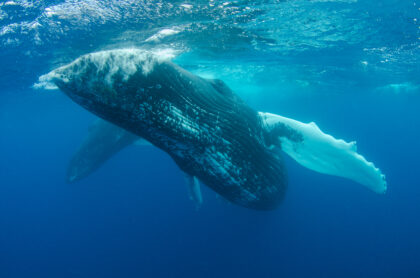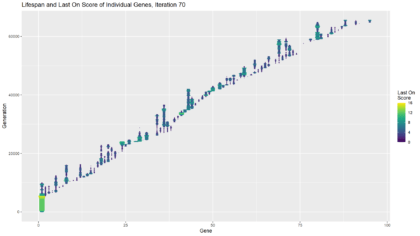
I was fortunate to grow up within visiting distance of the American Museum of Natural History in New York City. One item stands out in my memories from periodic visits: the blue whale. Not a live one, of course; it’s a museum, not an aquarium. Even as an inert model, the blue whale was striking to little-boy-me–which is saying something since it shares a home with numerous dinosaur skeletons. Of course, that cohabitation only helps to underline just how much bigger blue whales are than even the biggest dinosaurs or their aquatic contemporaries. Setting aside the highly exaggerated depiction in Jurassic World, even the Mosasaurus that previously occupied the blue whale’s ecological niche was only about 2/3s the size. So of course I was curious about a news story on the genes of how whales, blue and otherwise, get so big.
That remarkable size does have one downside: whales do not make for the best lab animals. With mice, you can edit specific genes and then raise those mice for a few weeks and see what the impact is. With something smaller like fruit flies or yeast, you can disrupt all the genes individually and track the results. But a blue whale? Good luck building a lab big enough for a statistically meaningful sample. So we have to rely on less direct methods to infer the likely function of genes in whales. For starters, we can use homology to genes in other species. We take what we’ve learned in mice and other amenable critters and use that to make educated guesses about the functions of comparable genes elsewhere. For this study, Silva et al used that information to pick out whale genes likely to be involved in controlling size based on what those genes have been observed to do in other species.
With their narrowed down list of candidate genes, they looked for signs of positive selection. Such drastic changes in size are unlikely to be neutral, since they come with the cost of needing more food and higher risk of cancer (bigg). There would probably have to be some advantage to being bigger to outweigh those costs. Or alternatively, some change(s) occurred that mitigated the costs and made a drift to larger sizes possible; then that change would be selected for since it would be advantageous irrespective of size. Either way, there should be a signature of selection. What that looks like is a different ratio of the kinds of mutations. If there is no selection, DNA mutations should accumulate at comparable rates throughout the gene, but if there is selection then mutations which change amino acids should be relatively more abundant. And that’s exactly what the researchers found in four of the genes.

They also found an ex-gene (not to be confused with an X gene, the fictional factor which gives the X-Men their super powers). In some whales, specifically baleen whales, the epidermal growth factor (EGF) gene was found to be a pseudogene. Gene sequences have start and stop indicators, similar in function to the capital letter that starts sentences and the punctuation that ends them. The baleen whales have stop indicator in their EGF gene much earlier than their cousins do, like an unexpected period in the midd. The fact that EGF is a pseudogene in baleen whales is notable because baleen whales have no teeth, and EGF has been shown in other species to regulate the growth of teeth. It’s likely then that the mutation in EGF was a significant one in the transition from teeth to baleen.
Last month we talked about one pathway for creating new genes, and now we have the flipside: a mechanism for losing genes. Over extended time periods, there is extensive turnover in genes. We saw an illustration of this phenomenon in one of our simulation experiments. In a sense, this is the same pattern we see with species. As we noted, the Mosasaurus used to occupy the ecological niche that whales now occupy; many mammals now fill roles in the ecosystem that dinosaurs used to play. In both cases, gene networks and food webs, long-term stability is maintained by significant dynamism.
That picture of life can be a challenging one. “If it ain’t broke, don’t fix it” has a folksy, intuitive appeal. Once you’ve solved a problem, you don’t want to keep solving it; just set it and forget it. But for whatever reason, we live in a world in which continual renewal is often necessary to maintain a given circumstance. It brings to mind Tim Keller’s thoughts on church planting. Naturally he has many thoughts, but the section “We Plant Churches Because We Want to Continually Renew the Whole Body of Christ” explains fairly well why change and growth are vital even when you don’t see anything you’d change. It also reminds me of the book of Judges and the cyclical nature of events it records. So I suppose I’ll be thinking about Deborah and Ehud the next time I’m at the natural history museum.
Andy has worn many hats in his life. He knows this is a dreadfully clichéd notion, but since it is also literally true he uses it anyway. Among his current metaphorical hats: husband of one wife, father of two teenagers, reader of science fiction and science fact, enthusiast of contemporary symphonic music, and chief science officer. Previous metaphorical hats include: comp bio postdoc, molecular biology grad student, InterVarsity chapter president (that one came with a literal hat), music store clerk, house painter, and mosquito trapper. Among his more unique literal hats: British bobby, captain’s hats (of varying levels of authenticity) of several specific vessels, a deerstalker from 221B Baker St, and a railroad engineer’s cap. His monthly Science in Review is drawn from his weekly Science Corner posts — Wednesdays, 8am (Eastern) on the Emerging Scholars Network Blog. His book Faith across the Multiverse is available from Hendrickson.

Leave a Reply